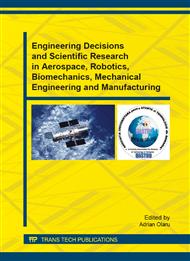p.166
p.174
p.180
p.188
p.194
p.205
p.213
p.219
p.225
The Influence of the Cutting Speed and Feed Rate on the Machinability Ratings in Machining of AISI 1045 Carbon Steel and AlSI1MgMn Aluminium Alloy
Abstract:
The research presented in this paper refers to the study of the influence of feed and cutting speed on the cutting forces, temperatures and chips formation in turning of AISI 1045 carbon steel and AlSi1MgMN aluminium alloy. This work presents both finite element simulation and experimental tests. Parameters have been considered variable in the process are cutting speed and feed, and depth of cut and tool geometrical parameters were kept constant. The purpose of the experimental procedure it was the acquisition data for cutting forces and temperatures by on-line monitoring, with KISTLER dynamometer for cutting forces and Flyr System ThermaCAM SC640 termography camera for temperatures. Both results obtained by finite element simulation and experimental tests show that the feed increasing lead to increased cutting forces and temperatures. Also, are presented the type of the chip obtained in orthogonal cutting of the two materials.
Info:
Periodical:
Pages:
194-204
Citation:
Online since:
October 2013
Price:
Сopyright:
© 2013 Trans Tech Publications Ltd. All Rights Reserved
Share:
Citation:


